Artificial Intelligence-Enabled Electrocardiogram Estimates Left Atrium Enlargement as a Predictor of Future Cardiovascular Disease
- PMID: 35207802
- PMCID: PMC8879964
- DOI: 10.3390/jpm12020315
Artificial Intelligence-Enabled Electrocardiogram Estimates Left Atrium Enlargement as a Predictor of Future Cardiovascular Disease
Abstract
Background: Left atrium enlargement (LAE) can be used as a predictor of future cardiovascular diseases, including hypertension (HTN) and atrial fibrillation (Afib). Typical electrocardiogram (ECG) changes have been reported in patients with LAE. This study developed a deep learning model (DLM)-enabled ECG system to identify patients with LAE.
Method: Patients who had ECG records with corresponding echocardiography (ECHO) were included. There were 101,077 ECGs, 20,510 ECGs, 7611 ECGs, and 11,753 ECGs in the development, tuning, internal validation, and external validation sets, respectively. We evaluated the performance of a DLM-enabled ECG for diagnosing LAE and explored the prognostic value of ECG-LAE for new-onset HTN, new-onset stroke (STK), new-onset mitral regurgitation (MR), and new-onset Afib.
Results: The DLM-enabled ECG achieved AUCs of 0.8127/0.8176 for diagnosing mild LAE, 0.8587/0.8688 for diagnosing moderate LAE, and 0.8899/0.8990 for diagnosing severe LAE in the internal/external validation sets. Notably, ECG-LAE had higher prognostic value compared to ECHO-LAE, which had C-indices of 0.711/0.714 compared to 0.695/0.692 for new-onset HTN, 0.676/0.688 compared to 0.663/0.677 for new-onset STK, 0.696/0.695 compared to 0.676/0.673 for new-onset MR, and 0.800/0.806 compared to 0.786/0.760 for new-onset Afib in internal/external validation sets, respectively.
Conclusions: A DLM-enabled ECG could be considered as a LAE screening tool and provide better prognostic information for related cardiovascular diseases.
Keywords: artificial intelligence; deep learning; electrocardiogram; left atrium; left atrium enlargement; new-onset atrial fibrillation; new-onset hypertension; new-onset mitral regurgitation; new-onset stroke.
Conflict of interest statement
The authors declare no competing interest.
Figures
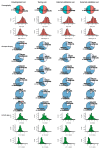


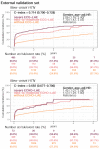
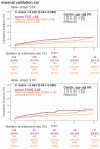
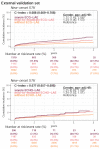
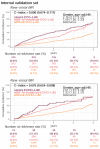
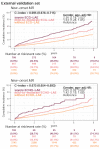
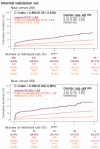
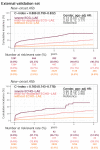




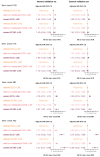
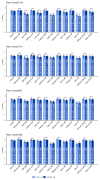
Similar articles
-
Artificial Intelligence-Enabled Electrocardiogram Predicted Left Ventricle Diameter as an Independent Risk Factor of Long-Term Cardiovascular Outcome in Patients With Normal Ejection Fraction.Front Med (Lausanne). 2022 Apr 11;9:870523. doi: 10.3389/fmed.2022.870523. eCollection 2022. Front Med (Lausanne). 2022. PMID: 35479951 Free PMC article.
-
Comparing Artificial Intelligence-Enabled Electrocardiogram Models in Identifying Left Atrium Enlargement and Long-term Cardiovascular Risk.Can J Cardiol. 2024 Apr;40(4):585-594. doi: 10.1016/j.cjca.2023.12.025. Epub 2023 Dec 30. Can J Cardiol. 2024. PMID: 38163477
-
Detection of Left Atrial Enlargement Using a Convolutional Neural Network-Enabled Electrocardiogram.Front Cardiovasc Med. 2020 Dec 17;7:609976. doi: 10.3389/fcvm.2020.609976. eCollection 2020. Front Cardiovasc Med. 2020. PMID: 33392274 Free PMC article.
-
The deep learning algorithm estimates chest radiograph-based sex and age as independent risk factors for future cardiovascular outcomes.Digit Health. 2023 Jul 28;9:20552076231191055. doi: 10.1177/20552076231191055. eCollection 2023 Jan-Dec. Digit Health. 2023. PMID: 37529539 Free PMC article. Review.
-
Left Atrial Enlargement and the Risk of Stroke: A Meta-Analysis of Prospective Cohort Studies.Front Neurol. 2020 Feb 14;11:26. doi: 10.3389/fneur.2020.00026. eCollection 2020. Front Neurol. 2020. PMID: 32117002 Free PMC article.
Cited by
-
Artificial Intelligence-Enabled Electrocardiography Detects B-Type Natriuretic Peptide and N-Terminal Pro-Brain Natriuretic Peptide.Diagnostics (Basel). 2023 Aug 22;13(17):2723. doi: 10.3390/diagnostics13172723. Diagnostics (Basel). 2023. PMID: 37685262 Free PMC article.
-
A Deep-Learning Algorithm-Enhanced Electrocardiogram Interpretation for Detecting Pulmonary Embolism.Acta Cardiol Sin. 2023 Nov;39(6):913-928. doi: 10.6515/ACS.202311_39(6).20230410B. Acta Cardiol Sin. 2023. PMID: 38022412 Free PMC article.
-
A Deep Learning Algorithm for Detecting Acute Pericarditis by Electrocardiogram.J Pers Med. 2022 Jul 15;12(7):1150. doi: 10.3390/jpm12071150. J Pers Med. 2022. PMID: 35887647 Free PMC article.
-
An AI-Enabled Dynamic Risk Stratification for Emergency Department Patients with ECG and CXR Integration.J Med Syst. 2023 Jul 31;47(1):81. doi: 10.1007/s10916-023-01980-x. J Med Syst. 2023. PMID: 37523102
-
Artificial Intelligence-Enabled Electrocardiogram Predicted Left Ventricle Diameter as an Independent Risk Factor of Long-Term Cardiovascular Outcome in Patients With Normal Ejection Fraction.Front Med (Lausanne). 2022 Apr 11;9:870523. doi: 10.3389/fmed.2022.870523. eCollection 2022. Front Med (Lausanne). 2022. PMID: 35479951 Free PMC article.
References
Grants and funding
LinkOut - more resources
Full Text Sources

